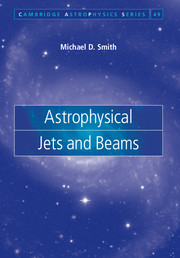Book contents
- Frontmatter
- Contents
- Preface
- 1 Introduction
- 2 Detection and measurement
- 3 The dynamical toolbox
- 4 Observations of extragalactic jets
- 5 Jets in galactic nuclei
- 6 Jets from young stars and protostars
- 7 Jets associated with evolved stars
- 8 Jets within the solar system
- 9 Jet launching
- 10 Jet propagation
- 11 The astrophysical jet
- References
- Index
7 - Jets associated with evolved stars
Published online by Cambridge University Press: 05 March 2012
- Frontmatter
- Contents
- Preface
- 1 Introduction
- 2 Detection and measurement
- 3 The dynamical toolbox
- 4 Observations of extragalactic jets
- 5 Jets in galactic nuclei
- 6 Jets from young stars and protostars
- 7 Jets associated with evolved stars
- 8 Jets within the solar system
- 9 Jet launching
- 10 Jet propagation
- 11 The astrophysical jet
- References
- Index
Summary
This chapter presents a mixed bag of objects and phenomena from planetary nebula to gamma-ray bursts. The data are fragmentary with results often representing the behaviour of selected attractive objects which may be contradicted by further observations. Nevertheless, the importance of stellar jets to the overall progress in the topic is now immense. This promotion has been earned by the short timescales involved and the known properties of the driving sources. This provides opportunities to track changes in jets, which are often transient, and to relate these changes to the launching accretion disc and star.
The evolutionary timescales associated with accretion discs and jets should scale with the luminosity and mass of the central object. Therefore, the changes that would take millions of years in quasars should occur over just hours and days in galactic sources. Much depends on the escape speed from near the surface of the particular star. Symbiotics and supersoft sources are accreting white dwarfs. Microquasars are radio-emitting X-ray binaries with a radio morphology like quasars and high X-ray luminosity. The primary can be a neutron star or black hole. Gamma-ray bursts are associated with collapsars or hypernovae, which generate black holes and ultra-relativistic jets.
For each set of objects, we define (1) the driving set-up, i.e. the stellar system; (2) the major discoveries; (3) the source activity behind or accompanying the jet launching, e.g. outbursts; and (4) the jet phenomena. The review strategy assumed here is one of speed: we begin with the slower jets and finish with superluminal motions.
- Type
- Chapter
- Information
- Astrophysical Jets and Beams , pp. 121 - 143Publisher: Cambridge University PressPrint publication year: 2012

